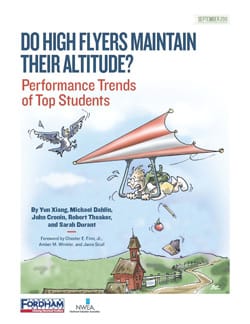If America is to remain internationally competitive, we need to maximize the potential of our top students. Over the last decade, however, federal and state education-accountability systems?particularly in the wake of the No Child Left Behind Act (NCLB) of 2001?have placed primary emphasis on moving low-performing students toward proficiency. The sanctions stemming from these systems have cast greater attention on schools that fail to attain proficiency for most students?a necessary and noble endeavor. But they have also fueled concerns that the academic needs of high-performing learners, who in many states are largely unaffected by accountability systems, have been neglected.
 In order to maximize the potential of our above-average and top students, we first need to know who those students are, and where and when they're most likely to falter. But to date, few research studies have examined the progress of individual high achievers over time.
In order to maximize the potential of our above-average and top students, we first need to know who those students are, and where and when they're most likely to falter. But to date, few research studies have examined the progress of individual high achievers over time.
Today, Fordham took a leap in that direction with the release of a groundbreaking study, Do High Flyers Maintain Their Altitude? Performance Trends of Top Students, the first ever to examine the achievement of high-performing students over time at the individual level. It poses?and seeks to answer?this straightforward question: Do students who outscore their peers on standardized achievement tests remain at the top of the pack year after year? Put differently, how many ?high flyers? maintain their ?altitude? over time? How many fall back toward Earth as they make their way through school, losing the academic edge they once enjoyed?
Over the next few days, we'll delve into the report's main findings and host a forum for expert guests to react here on Flypaper. If you just can't wait to find out more, you can download a copy of Do High Flyers Maintain Their Altitude? Performance Trends of Top Students here, or visit the report data gallery, hosted by the Kingsbury Center at the Northwest Evaluation Association, here.
?Janie Scull
